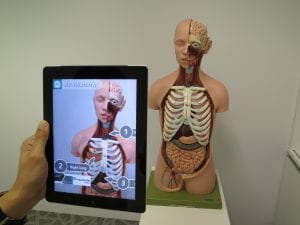
zedinteractive / Pixabay
The technology revolution, pervasive use of the internet and plethora of personal devices have changed the way society engages in employment, recreation, education and personal endeavours.
Educators need to keep abreast of emerging technologies so that they can ensure students possess the necessary digital skills and strategies to thrive in the 21st century (Wolz, 2019). Emanating software such as augmented and virtual reality are being trialed by many teachers seeking methods in which to improve engagement, bolster ICT acuity and meet the needs of the modern student. This article seeks to define AR, identify its role in pedagogical practice, role in meeting curriculum outcomes, and inferences of future applications.
WHAT IS AR
Augmented reality (AR) is when a computer generated layer of information is placed over a person’s experience of the world (Townsdin & Whitmer, 2017; Oddone, 2019). Wu, Lee, Chang & Liang (2013) define AR as technology that uses accurate 3D visual representations to combine real with virtual worlds. Generally viewed using mobile device applications or wearable computers, AR displays the augmented media in the form of images, sounds, videos, graphics or GPS data (Townsdin & Whitmer, 2017; Wu et al. 2013). At this point, AR is already in use within military machinery, theatre, flight navigation, entertainment industry and various mobile applications, i.e. Pokemon Go (Pope, 2018a; Townsdin & Whitmer, 2017). There are two forms of AR. The first form is when an interaction is stimulated between an image and a smart device, and the second is when the GPS triggers the digital information over the user’s location (Oddone, 2019, p.3). Whereas virtual reality (VR) is when a user is completely immersed into an artificial world with the aid of technology (Oddone, 2019). This technology has the ability to flood the senses and trick the mind into believing that the user is actually experiencing the event.
AR resources are activated by an application that ‘reads’ a QR code, image or illustration so that the interactive content is released. Levski (2018) points out that this added material could be as simple as a hidden photo or video, but could also be animated sequences or even an embedded game. The addition of these interactive elements is based upon the gamification principle, which relies on positive feedback to keep students motivated. By supporting interaction between the real and virtual world, AR allows the user to actively manipulate a tangible interface and thus increase the learner engagement and boost information retention (Saidin, Abd Hali & Yahaya, 2015; Wolz, 2019). This interaction means that AR is self paced, promotes independent learning and allows students to progress at their own cognitive capabilities. There is great potential for AR in educational practices, it can be embedded into print or digital resources, used across disciplines, and its multimodal nature gives diverse learners multiple entry points into the content (Levski, 2018).
References:
Levski, Y. (2018). 10 Augmented Reality Books That Will Blow Your Kid’s Mind. AppReal- VR [Blog]. Retrieved from https://appreal-vr.com/blog/10-best-augmented-reality-books/
Oddone, K. (2019). Even better than the real thing? Virtual and augmented reality in the school library. SCIS Connections. (110). Retrieved from https://www.scisdata.com/media/1921/scis-connections-110.pdf
Pope, H. (2018a). Virtual and augmented reality in libraries. Library Technology Reports – American Library Association, (54)6.
Saidin, N. Abd Halim, N., & Yahaya, N. (2015). A review of research on augmented reality in education: Advantages and applications. International Education Studies, 8(13). Retrieved from http://citeseerx.ist.psu.edu/viewdoc/download?doi=10.1.1.730.8456&rep=rep1&type=pdf
Townsdin, S., & Whitmer, W. (2017). Technology. Public Services Quarterly. 13. Pp190-199. DOI: 10.1080/15228959.2017.1338541
Wolz, K. (2019). Building faculty competence and self efficacy for using ZSpace virtual reality (VR) software in the classroom. All Regis University Theses. Retrieved from https://epublications.regis.edu/cgi/viewcontent.cgi?article=1930&context=theses
Wu, H., Lee, S., Chang, H., & Liang, J. (2013). Current status, opportunities and challenges of augmented realiy in education. Computers & Education, 62. Pp41-49. Retrieved from https://doi.org/10.1016/j.compedu.2012.10.024